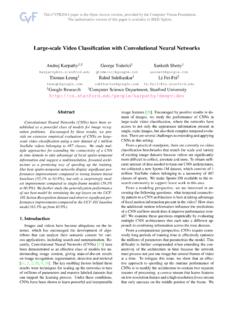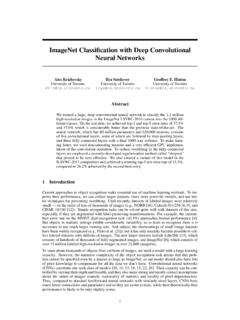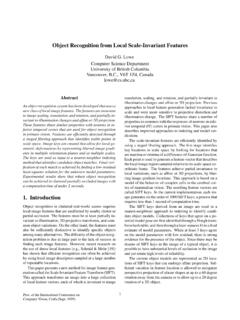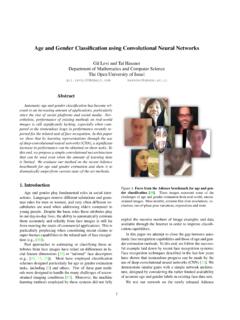Transcription of CHAPTER Naive Bayes and Sentiment Classification
1 Speech and Language Processing. Daniel Jurafsky & James H. Martin. Copyright 2021. Allrights reserved. Draft of December 29, Bayes and SentimentClassificationClassificationlie s at the heart of both human and machine intelligence. Decidingwhat letter, word, or image has been presented to our senses, recognizing facesor voices, sorting mail, assigning grades to homeworks; these are all examples ofassigning a category to an input. The potential challenges of this task are highlightedby the fabulist Jorge Luis Borges (1964), who imagined classifying animals into:(a) those that belong to the Emperor, (b) embalmed ones, (c) those thatare trained, (d) suckling pigs, (e) mermaids, (f) fabulous ones, (g) straydogs, (h) those that are included in this classification, (i) those thattremble as if they were mad, (j) innumerable ones, (k) those drawn witha very fine camel s hair brush, (l) others, (m) those that have just brokena flower vase, (n) those that resemble flies from a language processing tasks involve classification, although luckily our classesare much easier to define than those of Borges.
2 In this CHAPTER we introduce the naiveBayes algorithm and apply it totext categorization, the task of assigning a label ortextcategorizationcategory to an entire text or focus on one common text categorization task, Sentiment analysis, the ex-sentimentanalysistraction ofsentiment, the positive or negative orientation that a writer expressestoward some object. A review of a movie, book, or product on the web expresses theauthor s Sentiment toward the product, while an editorial or political text expressessentiment toward a candidate or political action. Extracting consumer or public sen-timent is thus relevant for fields from marketing to simplest version of Sentiment analysis is a binary classification task, andthe words of the review provide excellent cues.
3 Consider, for example, the follow-ing phrases extracted from positive and negative reviews of movies and likegreat,richly,awesome, andpathetic, andawfulandridiculouslyare veryinformative cues:+..zany characters and richly applied satire, and some great plot twists It was pathetic. The worst part about it was the boxing +..awesome caramel sauce and sweet toasty almonds. I love this place! ..awful pizza and ridiculously detectionis another important commercial application, the binary clas-spam detectionsification task of assigning an email to one of the two lexical and other features can be used to perform this classification. For ex-ample you might quite reasonably be suspicious of an email containing phrases like online pharmaceutical or WITHOUT ANY COST or Dear Winner.
4 Another thing we might want to know about a text is the language it s writtenin. Texts on social media, for example, can be in any number of languages andwe ll need to apply different processing. The task oflanguage idis thus the firstlanguage idstep in most language processing pipelines. Related text classification tasks likeau-thorship attribution determining a text s author are also relevant to the digitalauthorshipattributionhumanities, social sciences, and forensic NAIVEBAYES ANDSENTIMENTCLASSIFICATIONF inally, one of the oldest tasks in text classification is assigning a library sub-ject category or topic label to a text. Deciding whether a research paper concernsepidemiology or instead, perhaps, embryology, is an important component of infor-mation retrieval.
5 Various sets of subject categories exist, such as the MeSH (MedicalSubject Headings) thesaurus. In fact, as we will see, subject category classificationis the task for which the Naive Bayes algorithm was invented in is essential for tasks below the level of the document as ve already seen period disambiguation (deciding if a period is the end of a sen-tence or part of a word), and word tokenization (deciding if a character should bea word boundary). Even language modeling can be viewed as classification: eachword can be thought of as a class, and so predicting the next word is classifying thecontext-so-far into a class for each next word. A part-of-speech tagger ( CHAPTER 8)classifies each occurrence of a word in a sentence as, , a noun or a goal of classification is to take a single observation, extract some usefulfeatures, and therebyclassifythe observation into one of a set of discrete method for classifying text is to use handwritten rules.
6 There are many areas oflanguage processing where handwritten rule-based classifiers constitute a state-of-the-art system, or at least part of can be fragile, however, as situations or data change over time, and forsome tasks humans aren t necessarily good at coming up with the rules. Most casesof classification in language processing are instead done viasupervised machinelearning, and this will be the subject of the remainder of this CHAPTER . In supervisedsupervisedmachinelearninglearn ing, we have a data set of input observations, each associated with some correctoutput (a supervision signal ). The goal of the algorithm is to learn how to mapfrom a new observation to a correct , the task of supervised classification is to take an inputxand a fixedset of output classesY=y1,y2.
7 ,yMand return a predicted classy Y. For textclassification, we ll sometimes talk aboutc(for class ) instead ofyas our outputvariable, andd(for document ) instead ofxas our input variable. In the supervisedsituation we have a training set ofNdocuments that have each been hand-labeledwith a class:(d1,c1),..,(dN,cN). Our goal is to learn a classifier that is capable ofmapping from a new documentdto its correct classc C. Aprobabilistic classifieradditionally will tell us the probability of the observation being in the class. Thisfull distribution over the classes can be useful information for downstream decisions;avoiding making discrete decisions early on can be useful when combining kinds of machine learning algorithms are used to build classifiers.
8 Thischapter introduces Naive Bayes ; the following one introduces logistic exemplify two ways of doing like naiveBayes build a model of how a class could generate some input data. Given an ob-servation, they return the class most likely to have generated the like logistic regression instead learn what features from theinput are most useful to discriminate between the different possible classes. Whilediscriminative systems are often more accurate and hence more commonly used,generative classifiers still have a Naive Bayes ClassifiersIn this section we introduce themultinomial Naive Bayes classifier, so called be- Naive Bayesclassifiercause it is a Bayesian classifier that makes a simplifying ( Naive ) assumption NAIVEBAYESCLASSIFIERS3how the features intuition of the classifier is shown in Fig.
9 We represent a text documentas if it were abag-of-words, that is, an unordered set of words with their positionbag-of-wordsignored, keeping only their frequency in the document. In the example in the figure,instead of representing the word order in all the phrases like I love this movie and I would recommend it , we simply note that the wordIoccurred 5 times in theentire excerpt, the wordit6 times, the wordslove,recommend, andmovieonce, andso love this movie! It's sweet, but with satirical humor. The dialogue is great and the adventure scenes are It manages to be whimsical and romantic while laughing at the conventions of the fairy tale genre. I would recommend it to just about anyone. I've seen it several times, and I'm always happy to see it again whenever I have a friend who hasn't seen it yet!
10 It of the multinomial Naive Bayes classifier applied to a movie review. The position of thewords is ignored (thebag of wordsassumption) and we make use of the frequency of each Bayes is a probabilistic classifier, meaning that for a documentd, out ofall classesc Cthe classifier returns the class cwhich has the maximum posteriorprobability given the document. In Eq. we use the hat notation to mean our estimate of the correct class . c=argmaxc CP(c|d)( )This idea ofBayesian inferencehas been known since the work of Bayes (1763),Bayesianinferenceand was first applied to text classification by Mosteller and Wallace (1964). Theintuition of Bayesian classification is to use Bayes rule to transform Eq. intoother probabilities that have some useful properties.

















